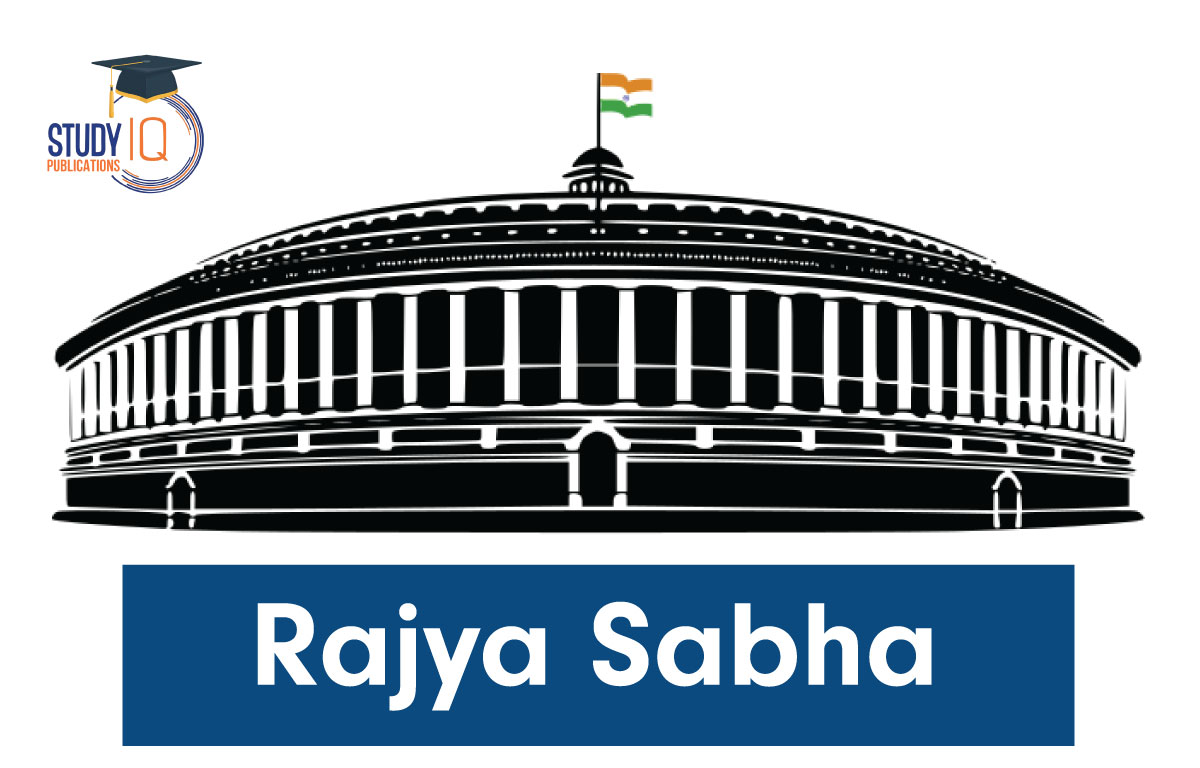Table of Contents
The Rajya Sabha is the Upper House of the Indian Parliament and is permanent, meaning it cannot be dissolved. Members serve six-year terms, with one-third retiring every two years, allowing for staggered elections. Retired members can be re-elected.
The Rajya Sabha has 250 members: 238 are elected by the state assemblies using a single transferable vote, while 12 are nominated by the President on the advice of the council of ministers. The election process is mentioned in Article 80(1) of the Indian Constitution, ensuring proportional representation for each state. To be a member, as per Article 84, one must be an Indian citizen, at least 30 years old, and not hold an office of profit. Article 102 lists disqualifications, including holding an office of profit, being of unsound mind, or not being a citizen of India.
Rajya Sabha Background
India’s fight for independence included a demand for representative government. The Rajya Sabha, or Council of States, was established in 1952, influenced by the Montague-Chelmsford Report of 1919, which suggested a second chamber.
The original Council, formed under the 1919 Government of India Act, was not fully democratic, favoring wealthy landowners and excluding women. It served colonial interests, not independence.
In 1928, the Nehru Committee pushed for a bicameral legislature. Jawaharlal Nehru led a committee to outline this structure as India neared independence.
Although Nehru doubted its effectiveness, he supported the Council’s creation to allow diverse political voices and review lower house laws. The Council of States aims to unify the nation by representing various states and cultures. Dr. S. Radhakrishnan, the first Vice-President and Rajya Sabha Chairman, highlighted its role in legislation and preventing rushed decisions.
The Council continues to reflect India’s founding leaders’ vision.
Read about: Lok Sabha
Rajya Sabha Composition
Composition/Strength According to Article 80 of the Constitution, the Rajya Sabha can have a maximum of 250 members, of which 12 are chosen by the President and 238 are elected by the States and the two Union Territories. The members proposed by the President are individuals with unique expertise or relevant experience in fields including literature, science, art, and social service.
Allocation of Seats The Constitution’s Fourth Schedule outlines how seats in the Rajya Sabha would be distributed among the States and Union Territories.
Read about: List of Prime Minister of India
Rajya Sabha and Eligibility for Becoming Members
The Constitution’s Article 84 outlines the requirements for membership in Parliament. To be eligible for Rajya Sabha membership, a person must meet the following requirements
He must be an Indian citizen, swear or affirm before a person the Election Commission has authorized in this regard, and do so in the manner described in the Third Schedule to the Constitution. He also needs to be at least 30 years old and meet any additional requirements imposed in this regard by or pursuant to any law passed by Parliament.
Process for Election of a Member of Rajya Sabha
The Rajya Sabha is elected through an indirect election process for the representatives of the States and Union Territories. According to the proportional representation system, using a single transferable vote, the elected members of the Legislative Assembly of each State and two of the Union territories elect the representatives for those States and those Union Territories.
The elected members of the Delhi Legislative Assembly make up the Electoral College for the National Capital Territory of Delhi, and the elected members of the Puducherry Legislative Assembly make up the electoral college for Puducherry.
Obtaining the necessary number of votes is necessary for a contender to obtain a Rajya Sabha seat. The formula listed below is used to determine that number. A required vote is equal to the sum of the votes cast divided by the number of Rajya Sabha seats plus one.
Read about: Important Articles of Indian Constitution
Chairperson and Deputy Chairperson of Rajya Sabha (Articles 89 & 90)
Chairman: The Vice-President of India is the ex officio Chairman of the Rajya Sabha.
Deputy Chairman: The Rajya Sabha elects a Deputy Chairman from among its members. If the Deputy Chairman’s position becomes vacant, the Rajya Sabha will elect another member. The Deputy Chairman must resign if they are no longer a member of the Rajya Sabha and can resign at any time by writing to the Chairman.
The Deputy Chairman can be removed by a majority vote in the Rajya Sabha, but there must be a 14-day notice before the vote. The Chairman (Vice-President) cannot be removed separately; if they stop being Vice-President, they also stop being Chairman.
Acting as Chairman (Articles 91 & 92)
If the Chairman’s position is vacant, or if the Vice-President is acting as President, the Deputy Chairman takes over the Chairman’s duties. If both the Chairman and Deputy Chairman are absent, another member appointed by the President will take on those duties. When the Chairman is absent from a sitting, the Deputy Chairman or another designated member will act as Chairman. While a resolution to remove the Vice-President or Deputy Chairman is being discussed, they cannot preside over that meeting but can still be present and participate in discussions, though they cannot vote.
Other Countries Council
Many democratic countries have their own versions of an Upper House or council. In the European Union, most countries have a council of states that acts as an advisory body to the government.
For example:
- The Belgian Council of States provides legal advice on draft bills.
- The Chinese State Council is the highest administrative body in China.
- The Portuguese State Council advises the President.
In the United States, there isn’t a body like the Rajya Sabha. However, it has a bicameral legislature made up of the House of Representatives and the Senate, with each state having two senators
Role of Rajya Sabha
As a Revising Chamber
Rajya Sabha performs a special duty as a reviewing chamber. Its responsibility as a Second Chamber is to ensure that hurriedly crafted legislation receives a second, deliberate review. If the Bills that the Rajya Sabha changed were examined, it would become clear that the Rajya Sabha had made suggestions for changes to the Bills passed by the Lok Sabha in a number of cases, and those recommendations had eventually been implemented.
Federal politics in India’s safety valve
In order to provide the federal divisions representation, a federal constitution must be bicameral. While there are frequently checks and balances between the executive branch, legislative branch, and judicial branch, the Council of States acts as a safety valve inside the legislative itself to reduce federal tensions. Rajya Sabha is thus a crucial component of the constitutional checks and balances system, along with the well-known instances of responsible management and judicial scrutiny.
A Deliberative Body
Because Parliament is more than merely a legislative body, the members have the chance to discuss important issues of public interest. The role of the Upper House is to be a deliberative body in order to counteract the “fickleness and passion” of the Lok Sabha.
Taking Care of the Vulnerable Groups
Women, religious, ethnic, and linguistic minorities are not adequately represented in the Lok Sabha (due to first past the post-election system). As a result, people would have the chance to take part in the legislative process of the nation by indirectly electing representatives to the Rajya Sabha. Rajya Sabha can therefore accept members who would not be able to win a public mandate..
Read about: Preamble of Indian Constitution
Special Powers of Rajya Sabha
The Rajya Sabha is granted several specific powers by the Constitution to carry out its federal purpose since it represents States and Union territories in Parliament, in addition to the coordination powers it shares with the Lok Sabha. Such unique powers support its position as an Upper House in comparison to the Lok Sabha.
It can start central intervention in the state legislative arena because it is a federal chamber. According to Article 249 of the Constitution, the Rajya Sabha may pass a resolution stating that it is necessary or expedient in the national interest for Parliament to make laws with regard to any issue listed in the State List by a majority of not less than two-thirds of the Members present and voting.
If such a resolution is approved, Parliament will be given the power to pass legislation covering the resolution’s designated subject for all or any portion of Indian Territory. This resolution will stay in effect for the time frame, not to exceed one year, that may be defined therein, but it may be extended by additional resolutions by one year increments.
According to Article 312 of the Constitution, if the Rajya Sabha approves a resolution declaring that it is necessary or expedient in the national interest to create one or more All India Services common to the Union and the States by a vote of at least two-thirds of the members present and voting, Parliament will have the authority to enact laws establishing such services.
Read about: List of Chief Ministers of Delhi
Conclusion
In 1960, Prime Minister Jawaharlal Nehru highlighted the Rajya Sabha’s crucial role in shaping major policies. Over five decades, the Council of States has excelled as a revisory chamber, deliberative body, and legislative apparatus, contributing significantly to India’s bicameral system. The Rajya Sabha is known for its lively Question Hour, engaging debates, and serious discussions on national and international issues. It has earned admiration for its legislative initiatives and constitutional authority. Prominent personalities often seek to serve in this esteemed body, as it represents the mainstream of public life.
Prime Minister Atal Bihari Vajpayee once remarked that no public figure’s career is complete without a stint in the Council of States. The Rajya Sabha is held in high esteem, and its traditions are expected to continue advancing India’s democracy.
Chairman Bhairon Singh Shekhawat emphasized the importance of evaluating the House’s proceedings for their contribution to public governance and welfare. The Council of States has become a leading second chamber, enriching the principles of bicameralism in both theory and practice.
Rajya Sabha Facts for UPSC
- Rajya Sabha has always contributed positively and successfully. It has been highly effective at influencing government policies and the legislative process.
- In its capacity as a federal chamber, it has strived to preserve the integrity and unity of the country and has increased public confidence in parliamentary democracy.
- All Rajya Sabha members are always encouraged to speak in their native tongues during discussions.
- The 12 members that the President has nominated bring to the house their knowledge from various sectors.


 MPPSC FSO Recruitment Notification 2025 ...
MPPSC FSO Recruitment Notification 2025 ...
 UNESCO World Heritage Sites of India Lis...
UNESCO World Heritage Sites of India Lis...
 Consolidated Fund of India, Meaning and ...
Consolidated Fund of India, Meaning and ...





















